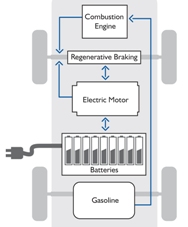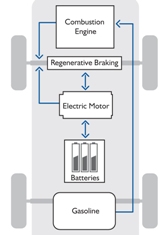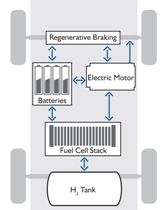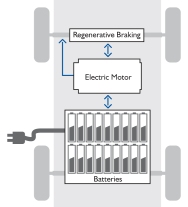![]()
![]()

![]()
About
|
The project's purpose is to develop the existent world-wide state of the art solutions on electrical transport systems from the propulsion's system (electrical drive system - electrical motor) point of view. In this project are proposed and initialized different new solutions for electrical vehicles control (electrical vehicle with rechargeable battery) having in view the optimization of the energy consumption and so, to obtain a higher autonomy of the electrical vehicle. The proposed sensor less control will eliminate all kind of sensors (i.e. speed, position and torque). Thus, it is expected to obtain a more secure transport vehicle for people and goods. Using Fuzzy technologies (that allow a better transposition of human thinking in real control systems than the classical logic algorithms), the system will minimize the energy consumption for the starting/braking periods but, also for long-periods of normal operating time. The minimum consumption of energy implies an increase lifetime of the system's batteries. An approach of the control systems for hybrid and non-hybrid rechargeable battery vehicles is performed, that covers about 90% of the electrical vehicles world market. Taking into account that the electrical propulsion motor may have different construction types (for example: induction motor, variable reluctance synchronous motor, permanent magnet synchronous motor) the selection will be made after performing a detailed analysis over specific control for every type. The optimal control method will decide which type of motor will be used. The project includes experimental validation to demonstrate the viability of the new applied technologies for electrical vehicle motion control. The obtained solutions offer immediate technical advantages that tend to become in the near future very efficient from the economical point of view. Another objective of the project represents the designing of an experimental simulator composed by the driving systems, propulsion electrical motors, inertial masses, different type of loads, control systems based on digital signal processors (DSP) and microcontrollers. The suitable solution is to be found for the converter - electrical motor - control algorithm assembly, to get minimum energy consumption and to increase the operating safety and the system's autonomy. These demands will lead to a cut of the production costs for the electrical vehicle that represents one of the main obstacles in using them on a very large scale.
Classical transport systems (use fossil fuel) even though from the exponential development of technologies point of view the main issue represents the global voluntary pollution. Albeit the depollution systems of these vehicles are continuously improving, another issue is rising, and that is the depletion of fossil fuel in about 30-50 years. Thus, the electrical transport system (electrical vehicle) represents a suitable solution for the future transportation. The researches in this field aim two main objectives: the designing of new energy stocking sources (clean energy sources) and the development of the existing ones; the development of optimal electric propulsion systems from the power consumption with respect to energy as a limited resource. In general, an electrical transport system is an electrical vehicle whose torque is transmitted to the wheels through an electrical motor that uses energy only from batteries, or through an internal combustion engine that may use as a primary source the hydrogen, gas or fuel cells. The electrical drive technology is used for vehicles like bikes and motor scooters and ending with elevators, golf vehicles, passenger vehicles, buses, trolley buses, and commercial vehicles. This technology is also used in maritime ports or airports. The electrical vehicles may be classified in four main categories: rechargeable battery vehicles, rechargeable battery hybrid vehicles, hybrid vehicles and fuel cell vehicles. On a worldwide level, the researches are focused on high efficiency electrical transport systems with high operating safety and obviously without nox emissions. In fact, the majority of people travel for example by bus, or watch how theirs luggage are transported towards the airplane, without realising that they are already the consumers of the electrical transport systems. Thus, we present some of electrical transport systems applications:
- commercial transportation - taxi: The electrical drives is very useful for vehicles with repeated stops and goo's, because it assures the recovering of the braking energy, that would have been lost as heat; typical applications for today urban commercial transportation include urban goods transportation, taxi and military vehicles;
- public transportation: buses, trolleybuses, high speed trains for example, in megacities like New York, Seoul, Tokio, where the offer of the electrical bus companies is raising continuously, taking care of the environment, and also, electrical buses are less noisy and the braking system's lifetime is practically doubled;
- electrical vehicles: Only recently electrical hybrid vehicles are available for end users, becoming very popular despite their high prices; the main majority of vehicle manufacturing companies aim to increase the number of hybrid vehicles in the near future. Even though, the economic analysis forecast, for example that the American hybrid vehicles market will weight only 3% until year 2011, and only because of the high prices. Albeit the researches on electrical vehicles for the end users markets stay almost exclusively in the big vehicle manufacturing companies preoccupations;
- stocking, goods travelling and person transportation on limited areas: Electrical vehicles, like electropilers, wares transporters or person transporters are wide-spread inside industrial companies, tourism resorts, university campus. For example the replacement of a piler with engine with an electropiler is equivalent to driving out about 170 common cars;
- wares transportations and person transport within airports or maritime ports: The electrical transportation technologies for airports include: luggage movement between the terminal and airplane, electrical luggage lorries, person transportation vehicles.
Keeping with the previous classification, one can distinguish some of characteristic features for every type of electrical system with having in view to the purposed research thematic within the current project.
Taking into account that common transportation vehicles (with internal combustion engines) are the main voluntary chemical pollution factors of the planet with noxes like CO, Nox, CH, carbon particles, Greenhouse gases(like CO2), and phonic pollution, the electrical transportation systems represent an important alternative for person and wares transportation. Albeit, for an increased efficiency and operating safety, optimal electrical transportation systems have to be developed in order to obtain a mass reduction and less power consumption. The safety refers to the use of a number of sensors for position, speed and torque also. The malfunction of these devices leads to a reduced operating safety and endurance of the whole drive system. In this sense, the researches on electrical drive systems are focused on sensorless drive systems. In Europe in 1998 has been founded an important research corporation (The European Sensorless Drives Consortium) directed by Prof. Peter Vas from the Aberdeen University, United Kingdom. Another imposed restriction on worldwide level is the diminish of classical resources, that is fossil fuel (oil, gas, coal) along with the exponential increase of energy demand. This is reflecting very clear in the exaggerated increase of the fossil fuel price. As a result, all the important participants at world economy are struggling to find new solutions. The most important power centres are: USA, Europe, South Korea and Japan. Especially in the last ten years the invested funds have become huge. Only the USA Government for example has invested over 2 billion dollars in the last three years. In Europe, Asia and USA, the vehicle manufactures have an enhanced research politics regarding battery electrical vehicles, hybird vehicles or fuel cell vehicles. An important number of connected industries is implied (for example battery manufacturers, electronic parts, electrical motors), universities and research institutes. The electrical energy suppliers are also interested on this matter because the electrical vehicle has potential on theirs markets. It also unanimously accepted that electrical vehicles with rechargeable battery (so called "pure electrical vehicles") have a great potential for the "niche market" such as: urban wares transportation, buses, vehicles dedicated to airports, postal services, materials storing and transportation etc.
Last update: April 06, 2007
. |
![]()
| ęCopyright 2005 DSP Control of Electrical Drives Lab@UPB All Rights Reserved For more information, please contact dragos@dsp-control.pub.ro |




